|
1648 to 1655
(links to map of Poland)
The First Cossack War
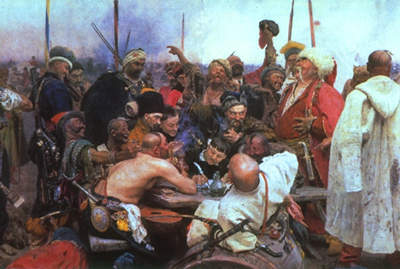 In
1648 the Cossacks rebelled again. This time they had a leader equal
to the task in Chmielniecki. On news of the disturbances in the
Sich Polish commander Nicholas Potocki set out for the Ukraine and
in February 1648 he camped at Korsun. He sent part of his force
(3-3,500) comprising regular troops and registered Cossacks to meet
Chmielniecki (10,000), which they did at Zlote Wody (Yellow Waters). In
1648 the Cossacks rebelled again. This time they had a leader equal
to the task in Chmielniecki. On news of the disturbances in the
Sich Polish commander Nicholas Potocki set out for the Ukraine and
in February 1648 he camped at Korsun. He sent part of his force
(3-3,500) comprising regular troops and registered Cossacks to meet
Chmielniecki (10,000), which they did at Zlote Wody (Yellow Waters).
For the first time the Cossacks had allied themselves
with the Tartars and together they formed a formidable fighting
force. The mainly Cossack infantry now had a superb mobile cavalry
arm while the solely cavalry Tartars had the assistance of the Cossacks
defensive firepower. The Poles on the other hand lacked a commander
of the stature of the recently deceased Koniecpolski.
At Zlote
Wody the registered Cossacks deserted the Royal army and in
the ensuing confusion the remaining forces were destroyed on 15th
May 1648. Eleven days later the main Polish army was defeated at
Korsun
and as news spread of these victories the whole of the Ukraine rose
in rebellion.
When he was most needed,
the much respected, King Wladyslaw IV died and with the Royal commanders
captured or killed Poland was without a leader.
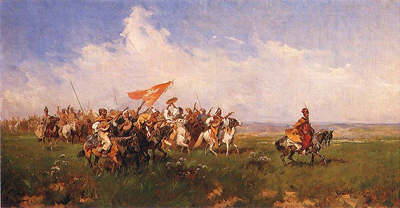 Fortunately
for Poland Chmielniecki delayed while he organised his forces and
his country, while the booty laden Tartars returned home. In September
1648 Chmielniecki moved further into Poland. With both Hetman's
Potocki and Kalinowski captured, the Polish forces, though substantial,
were ill disciplined and badly led by a group of three and defeated
at Pilawce
(10 to 23 October 1648). The improvised cavalry failed to make
any impression on the masses of Cossack infantry supported by the
skillful Tartars. The few regular infantry which had survived Zlote
Wody and Korsun (King's guard regiment and 'Wybraniecka'
infantry) did however acquit themselves well, defending the river
crossings with great courage before being overwhelmed. It was a
great material and morale catastrophe, and a pathetic military display.
One Cossack commander noted "these were not the Poles we knew,
the victors over the Turks and Muscovites, of Tartars and Germans,
but cowards and rabbits, children clad in steel. They died of fright
when they saw us". Chmielniecki then besieged Lvov and after
receiving a ransom moved on to Zamosc, but Fortunately
for Poland Chmielniecki delayed while he organised his forces and
his country, while the booty laden Tartars returned home. In September
1648 Chmielniecki moved further into Poland. With both Hetman's
Potocki and Kalinowski captured, the Polish forces, though substantial,
were ill disciplined and badly led by a group of three and defeated
at Pilawce
(10 to 23 October 1648). The improvised cavalry failed to make
any impression on the masses of Cossack infantry supported by the
skillful Tartars. The few regular infantry which had survived Zlote
Wody and Korsun (King's guard regiment and 'Wybraniecka'
infantry) did however acquit themselves well, defending the river
crossings with great courage before being overwhelmed. It was a
great material and morale catastrophe, and a pathetic military display.
One Cossack commander noted "these were not the Poles we knew,
the victors over the Turks and Muscovites, of Tartars and Germans,
but cowards and rabbits, children clad in steel. They died of fright
when they saw us". Chmielniecki then besieged Lvov and after
receiving a ransom moved on to Zamosc, but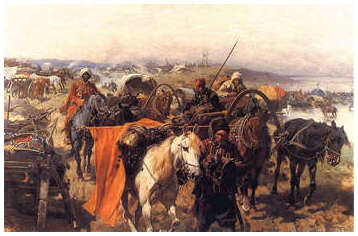 the impregnable fortress held and the Cossacks returned home for
the winter.
the impregnable fortress held and the Cossacks returned home for
the winter.
Large numbers of peasants joined the Cossack
army and with the Tartars they ravaged the land 'with fire and sword'
slaughtering nobles, Polish or Ruthenian, priests and nuns and Jews
in their thousands. The Tartars taught their Cossack allies many
lessons in cruelty including the Moldavian custom of impaling alive,
which was carried out with relish by Cossacks and Poles alike. No
one was in control on
either side and
the whole region degenerated into mindless
violence and cruelty.
In Warsaw Jan Kazimierz
(John Casimir) half-brother of
Wladyslaw was elected King.
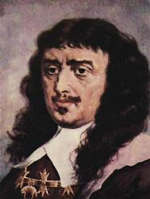 The
coronation Sejm of 1649 enlarged the standing army, placing its
financing partly on provinces of Poland and ended the registering
of Cossacks. In June 1649 the Cossacks recommenced military operations
when their Tartar allies returned. Polish forces retreated to the
fortified camp of Zbaraz
(10 July to 25 August 1649) where a relatively small force of some
9,000 Polish troops held back the entire might of Chmielniecki and
the Khan for over six weeks. The new king moved to assist but was
met by Chmielniecki's main forces in a hard and indecisive two day
battle at Zborow
(15-16 August 1649). The Poles succeeded in buying off the
Khan and with Lithuanian forces operating in the East a truce was
reached which included a general amnesty. The
coronation Sejm of 1649 enlarged the standing army, placing its
financing partly on provinces of Poland and ended the registering
of Cossacks. In June 1649 the Cossacks recommenced military operations
when their Tartar allies returned. Polish forces retreated to the
fortified camp of Zbaraz
(10 July to 25 August 1649) where a relatively small force of some
9,000 Polish troops held back the entire might of Chmielniecki and
the Khan for over six weeks. The new king moved to assist but was
met by Chmielniecki's main forces in a hard and indecisive two day
battle at Zborow
(15-16 August 1649). The Poles succeeded in buying off the
Khan and with Lithuanian forces operating in the East a truce was
reached which included a general amnesty.
The Second Cossack War
Chmielniecki spent the next year maintaining the peace while making
preparations for the inevitable continuation of war. He managed
to raise an army of over 100,000 Cossacks had
political support from Turkey and military support from the Crimean
Tartars. He also hoped his rebellion, which had taken over the Ukraine,
would spread to the peasants in Poland. The Sejm agreed to the raising
of a 36,000 Royal and 15,000 Lithuanian army, giving the King the
authority to raise the levy. While Polish forces were concentrating
Hetman Kalinowski managed to loose half of his 12,000 force in operations
to shield the main army.
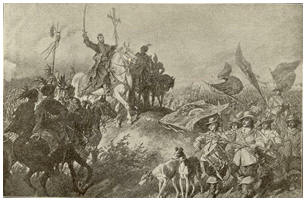 In
June 1651 the Khan Islam Giereja rejoined the Cossacks and together
they marched at the Polish forces. At the three day battle of Beresteczko
(28 to 30 June 1651) the Royal army (27,000 mercenaries and
30,000 noble levy) achieved a decisive victory and the Cossack-Tartar
army (60-80,000 Cossacks and 20-30,000 Tartars) retreated back to
the Dniepr. Again the noble levy cavalry showed their poor discipline
with the infantry saving the day and then ensuring a decisive defeat
was inflicted on the enemy. After the battle the noble levy, deciding
their duty was completed, dispersed while the remaining forces moved
towards the Ukraine and joined up with the equally victorious Lithuanian
army. Hetman Kalinowski, with complete victory within his grasp
agreed to a truce. Peace was agreed in September at Biala Cerkiew,
however it was even less successful than that agreed at Zborow.
The Poles carried out punitive expeditions against the Ukraine while
Chmielniecki punished with death the leaders of peasant riots. In
June 1651 the Khan Islam Giereja rejoined the Cossacks and together
they marched at the Polish forces. At the three day battle of Beresteczko
(28 to 30 June 1651) the Royal army (27,000 mercenaries and
30,000 noble levy) achieved a decisive victory and the Cossack-Tartar
army (60-80,000 Cossacks and 20-30,000 Tartars) retreated back to
the Dniepr. Again the noble levy cavalry showed their poor discipline
with the infantry saving the day and then ensuring a decisive defeat
was inflicted on the enemy. After the battle the noble levy, deciding
their duty was completed, dispersed while the remaining forces moved
towards the Ukraine and joined up with the equally victorious Lithuanian
army. Hetman Kalinowski, with complete victory within his grasp
agreed to a truce. Peace was agreed in September at Biala Cerkiew,
however it was even less successful than that agreed at Zborow.
The Poles carried out punitive expeditions against the Ukraine while
Chmielniecki punished with death the leaders of peasant riots.
In 1652 the Great Cossack Council renewed
hostilities with Poland and sent envoys to the Tsar and Khan for
assistance. On 2 June 1652 Hetman Kalinowski attempted to head off
Chmielniecki's move to Moldavia but was defeated at Batoh.
After the battle the Cossacks paid the Tartars to give them their
share of the prisoners so that they could be killed, amoungst the
dead was the brother of the future King Jan Sobieski, Marek. After
a short vain siege of Kamieniec Podolski the Cossack-Tartar army
returned home to seek further allies.
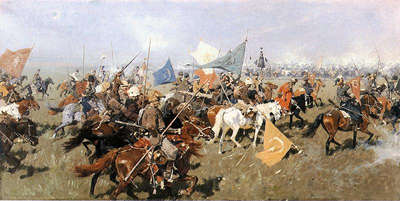 Batoh
led to a new 36,000 army with a much-reorganised financial base,
making forces easier to raise and maintain, the Kwarta tax was used
to maintain the artillery and fortifications. New financing gave
the name 'computed' for the regular army. The noble levy remained
as a last resort and there were periodic mobilisations and exercises.
Although the new system was by no means perfect it gave the Commonwealth
a powerful army and was a natural evolution from a mainly mercenary
to standing army. Batoh
led to a new 36,000 army with a much-reorganised financial base,
making forces easier to raise and maintain, the Kwarta tax was used
to maintain the artillery and fortifications. New financing gave
the name 'computed' for the regular army. The noble levy remained
as a last resort and there were periodic mobilisations and exercises.
Although the new system was by no means perfect it gave the Commonwealth
a powerful army and was a natural evolution from a mainly mercenary
to standing army.
The Cossack wars continued and on 18th January
1654 Chmielniecki submitted the Ukraine to the 'Tsars hand' and
Muscovy invaded Poland and Lithuania.
This was in violation of the Treaty of 1634 and Jan Kazimierz sent
deputations to the Sultan and the Khan for assistance against the
Tsar. The Ottomans allowed a Tartar alliance with the Poles, while
the Sejm of June 1654 raised noble levies of 35,000 for Poland and
18,000 for Lithuania.
Start of the Muscovite Wars
The Muscovite army attacked with three groups at Lithuania and one
at the Ukraine. The Muscovite army was numerous and well equipped
and now trained mainly in the Western manner with many foreign officers.
In Lithuania they were briefly checked by Janusz Radziwill's small
force, before pushing on to Smolensk. The winter halted further
operations. In the Ukraine the Polish-Tartar army met the Cossack-Muscovite
army at Ochmatow
(January 1655) and though the Muscovite forces were broken a decisive
result slipped from the Poles when the Tartars refused to fight
the Cossacks.
In the Summer of 1655 a new Muscovite army reached
Wilno and in two weeks turned the vibrant capital into a heap of
ashes, but another even more dangerous enemy appeared.
 5 5

|

![]()
 In
1648 the Cossacks rebelled again. This time they had a leader equal
to the task in Chmielniecki. On news of the disturbances in the
Sich Polish commander Nicholas Potocki set out for the Ukraine and
in February 1648 he camped at Korsun. He sent part of his force
(3-3,500) comprising regular troops and registered Cossacks to meet
Chmielniecki (10,000), which they did at Zlote Wody (Yellow Waters).
In
1648 the Cossacks rebelled again. This time they had a leader equal
to the task in Chmielniecki. On news of the disturbances in the
Sich Polish commander Nicholas Potocki set out for the Ukraine and
in February 1648 he camped at Korsun. He sent part of his force
(3-3,500) comprising regular troops and registered Cossacks to meet
Chmielniecki (10,000), which they did at Zlote Wody (Yellow Waters).
 Fortunately
for Poland Chmielniecki delayed while he organised his forces and
his country, while the booty laden Tartars returned home. In September
1648 Chmielniecki moved further into Poland. With both Hetman's
Potocki and Kalinowski captured, the Polish forces, though substantial,
were ill disciplined and badly led by a group of three and defeated
at
Fortunately
for Poland Chmielniecki delayed while he organised his forces and
his country, while the booty laden Tartars returned home. In September
1648 Chmielniecki moved further into Poland. With both Hetman's
Potocki and Kalinowski captured, the Polish forces, though substantial,
were ill disciplined and badly led by a group of three and defeated
at  the impregnable fortress held and the Cossacks returned home for
the winter.
the impregnable fortress held and the Cossacks returned home for
the winter.
 In
June 1651 the Khan Islam Giereja rejoined the Cossacks and together
they marched at the Polish forces. At the three day battle of
In
June 1651 the Khan Islam Giereja rejoined the Cossacks and together
they marched at the Polish forces. At the three day battle of  Batoh
led to a new 36,000 army with a much-reorganised financial base,
making forces easier to raise and maintain, the Kwarta tax was used
to maintain the artillery and fortifications. New financing gave
the name 'computed' for the regular army. The noble levy remained
as a last resort and there were periodic mobilisations and exercises.
Although the new system was by no means perfect it gave the Commonwealth
a powerful army and was a natural evolution from a mainly mercenary
to standing army.
Batoh
led to a new 36,000 army with a much-reorganised financial base,
making forces easier to raise and maintain, the Kwarta tax was used
to maintain the artillery and fortifications. New financing gave
the name 'computed' for the regular army. The noble levy remained
as a last resort and there were periodic mobilisations and exercises.
Although the new system was by no means perfect it gave the Commonwealth
a powerful army and was a natural evolution from a mainly mercenary
to standing army.